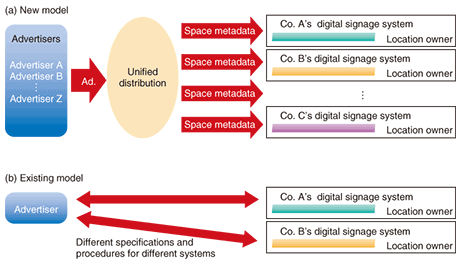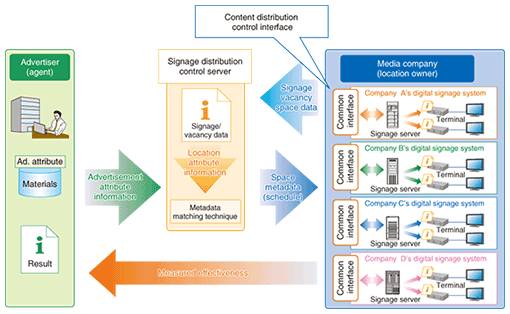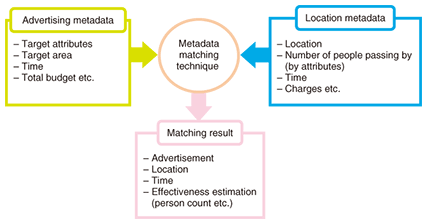 |
|||||||||||||||
|
|
|||||||||||||||
|
Special Feature: R&D on Digital Signage as an Advertising Medium Vol. 7, No. 12, pp. 5–9, Dec. 2009. https://doi.org/10.53829/ntr200912sf1 Metadata Delivery and Integration and Metadata Matching Technologies for Digital SignageAbstractThis article describes some key technologies for digital signage systems: (1) metadata delivery and integration technology for unified distribution of advertising content to signage systems via a unified interface and for distribution of metadata from signage systems of different manufacturers and (2) metadata matching technology for obtaining the optimum combination of advertising content and digital signage location.
1. IntroductionIn recent years, there have been indications of truly widespread use of digital signage. Signage displays catch the eyes of many people in shops and facilities, on the street, and inside vehicles. They are known as out-of-home media (OOH). Signage is known as the only medium that is both time- and location-specific; it excels at providing content to target audiences at a particular place and at particular times. For example, information can be tailored to locations with many office workers at night and many housewives during the day. Advantages such as this give signage tremendous potential as a new style of advertising medium, and the market is expected to expand to over one trillion yen by 2015 [4]. However, nearly all signage is currently used to provide information that is specific to the location, such as guidance information in facilities. Consequently, the signage is managed and operated in a manner that is limited to the location or within a company. To ensure a scale that is large enough to gain the awareness of many people as a future advertising medium, it is necessary to construct a network by connecting signage systems. Such a signage network would make it possible to create new added value in advertising by 1) delivering the same advertising content to multiple locations at low cost, 2) allowing flexible and realtime announcements and notifications, and 3) allowing interactive communication with people viewing the advertisements [1]–[3]. One major problem with implementing a signage network is setting common rules for content distribution. At present, the specifications for digital signage systems differ from location to location, and the content submission rules (e.g., content submission deadlines and methods of specifying distribution schedules) also differ from medium to medium. It is therefore necessary to recognize the differences in specifications and procedures among media when publishing the advertisement, but that takes time and effort. A new model for digital signage systems is shown in Fig. 1 and compared with the existing model.
In this article, we describe (1) metadata delivery and integration technology that uses metadata to enable the integration of many signage systems of various types and (2) metadata matching technology for allocating content that matches a display’s location and the time when that content is advertised. 2. Metadata delivery and integrationEfficient mass distribution of content or advertising to many types of signage requires a means of networking the signage of different manufacturers via a common interface. We have specified a content distribution control interface (common interface) by following the system guidelines (version 1) published by the Digital Signage Consortium [5]. 2.1 Distribution control interfaceThe technique described here assumes a system structure, shown in Fig. 2, in which the advertisements published by the advertiser (agent) are accepted by a signage distribution control server and distributed to multiple signage systems via the common interface. A study of commercial signage systems has revealed that scheduling information is generally managed by the signage server. By utilizing the metadata technology we have developed in our past R&D efforts for content distribution such as for IPTV (Internet protocol television), we have achieved efficient scheduling and unified distribution of content and advertisements to signage systems of different manufacturers by implementing them on signage servers via the common interface, which exchanges space metadata.
2.2 Space metadata2.2.1 OverviewThis technique specifies space metadata, which is common schedule information structured in XML (extensible markup language) format, for use by multiple signage systems. The basic items of the space metadata are time, display, and content data. Time data specifies the time when the content is to be displayed, display data specifies the device displaying the content, and content data specifies the content to be displayed. More advanced representations can be made by extending these items. 2.2.2 Distribution processThe process flow from the provision of content by the advertiser (agent) to feedback of distribution results is described below. 1) Registration of vacancy information: For each display device, the location owner registers information about the display device and its availability that describes when advertising can be displayed. 2) Registration of advertising attribute information: For each advertisement to be presented, the advertiser registers the advertising target and other such attribute information. 3) Setting of advertisement presentation location (media plan): The operator specifies schedule information that indicates when (time) and where (display device) the advertisement is to be displayed. In practice, the location owner confirms that the advertising content may be presented before the media plan is set. 4) Distribution of space metadata: The distribution control server generates space metadata from the schedule information set in step 3) and sends it to the signage system. 5) Display of content: The signage system displays the advertisements according to the schedule provided to it. 6) Notification of actual performance: After the advertisement has been displayed, the signage system sends a log to the distribution control server (or advertiser) to confirm that the advertisement was displayed on schedule. To avoid any interference with the freedom of location owners to schedule their own content, the vacancy information registration (step 1) is set by the location owner in advance to specify when the advertisement can be presented. 3. Metadata matchingNetworked signage systems offer a medium for distributing content with good timing according to advertising conditions such as the location of the signage or the time band available. However, there have been few attempts to exploit that feature by switching the advertising content according to the time period. We believe that is because it is unclear whether the effects are worth the trouble of performing time-aware media planning* and time-aware content production and the effort of operating the required distribution system. The key to coping with this problem is a metadata matching technique for efficient media planning through the selection of advertisement times and locations. This technique provides a framework that reduces the work involved in media planning and distribution system operation by managing advertising content attributes (advertising metadata) and signage location attributes (location metadata) as metadata and finding optimum combinations (Fig. 3).
In addition to the target attributes of the people passing by, such as sex, age, and occupation, the advertising metadata includes product category, rights information, temperature and weather information, time period, display size, and other such data relevant to the recommended advertising display environment. The location metadata includes the display size and location address and the number of people passing by broken down by sex and age. From that information, the metadata matching technique computes a score that basically represents the advertising effectiveness in order to find optimum combinations of suitable advertisement locations and times. In this computation, the target attributes and audience numbers included in the location metadata and the budget are important factors. If the location metadata includes time-band information, an even more detailed media plan can be formulated. For example, a finely detailed media plan can take into account location characteristics such as in the morning there are mostly students going to school, during the day there are people shopping, and at night there are company employees going to drinking establishments. Furthermore, if information about continuously changing phenomena such as the weather and temperature at the display site is collected, it will allow dynamic presentation of advertising content, which could make a more direct contribution to improved product sales. For example, an advertisement for iced tea could be presented on hot days and one for hot tea on cold days.
4. Concluding remarksWe applied the techniques described here in verification tests conducted from November 2008 to the end of March 2009 in collaboration with NTT Communications Corporation. Since February 2009, we have been conducting serviceability tests in collaboration with Dentsu Corporation. The verification tests highlighted the differences in signage system specifications and content submission rules for different display device locations and the trouble that those differences cause. There are fine differences in conditions such as the display device’s aspect ratio, the content format, and whether or not audio output is possible. It is thus clear that the production of multiple versions of advertisements for particular locations and display devices and the formulation of a complex media plan that takes into account various conditions are necessary when preparing advertisements for submission, and the work involved is a serious problem. We can say that these problems and the advantages of signage, which are the ability to use abundant advertising expressions and flexible and effective advertising, are two sides of the same coin. Some of the future problems we would like to treat are: improving the metadata delivery interface and integration techniques, formulating operating rules, and improving the metadata matching technique that takes into account the factors revealed by the tests, such as the compatibility of display specifications, content format, and the number of people pausing in front of the display. We believe that solving such problems will lead to unified development of the entire signage advertising market. References
|
|||||||||||||||
















